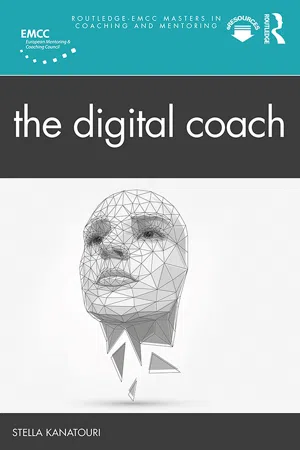
- 176 pages
- English
- ePUB (mobile friendly)
- Available on iOS & Android
The Digital Coach
About this book
Thanks to digital media, coaching doesn´t have to be constrained by geographical and temporal boundaries. Using digital media to facilitate coaching processes however, creates a distinct form of coaching practice that requires additional skill from the coach.
The Digital Coach contains insights based on a comprehensive, exploratory research that analysed the discussions of a 1,000 member strong online community of coaches and several interviews with coaches to understand their practical experiences of working with technology. At the same time, the book offers information, insights, and examples that can be readily used by the coaching practitioner. Based on the developments in the field, the book provides suggestions about improving the usability of coaching software, and it offers reflections on how emerging technologies like immersive Virtual Reality, Augmented Reality, and Artificial Intelligence might extend coaching practice. Whilst acknowledging the limitations and potential risks that may arise by integrating digital media in coaching, the book suggests that coaching success doesn't only depend on media capabilities, but also on the coach. The digital coach develops enhanced coaching skills and adapts coaching practice to the media in use.
The book is dedicated to the coaching practitioner who uses digital media or who is considering doing so, and is relevant for coaching supervisors, buyers of coaching services, human resource professionals, and software designers.
Frequently asked questions
- Essential is ideal for learners and professionals who enjoy exploring a wide range of subjects. Access the Essential Library with 800,000+ trusted titles and best-sellers across business, personal growth, and the humanities. Includes unlimited reading time and Standard Read Aloud voice.
- Complete: Perfect for advanced learners and researchers needing full, unrestricted access. Unlock 1.4M+ books across hundreds of subjects, including academic and specialized titles. The Complete Plan also includes advanced features like Premium Read Aloud and Research Assistant.
Please note we cannot support devices running on iOS 13 and Android 7 or earlier. Learn more about using the app.
Information
1
WHY DIGITAL COACHING?
Coaching as a valuable approach to human development
- The coach provides emotional support and shows empathy.
- The coach helps the client set SMART goals (specific, measurable, achievable, realistic, and time-bound).
- The coach guides the client to identify concrete solutions to the problem.
- The coach supports the client’s internal and external resource activation.
- The coach supports the client’s learning transfer into practice.
- Feedback about the client’s satisfaction with the process and post-action evaluation of progress.

Adding the technology element: what is ‘digital coaching’?
| Audio-only | Audio-visual | Text | Visual | |
|---|---|---|---|---|
| Coach–client dialogue |
|
|
| - |
| Complementary support to the coach–client dialogue |
|
|
|
|
| Machine–client interaction |
| - |
- Remote coaching (relational): Face-to-face communication is entirely replaced with technology-mediated communication, enabling coaching at a distance regardless of geographic location. Examples include telephone, synchronous and asynchronous text-based communication, video calls, HD videoconferencing, and avatar-based coaching. Remote coaching can be coach-led, where communication takes place between a human coach and client. Several interpersonal communication media – telephone and videoconferencing, emails – also enable coaching conversations in a group or team. Interpersonal communication media are discussed in Chapter 2.
- Remote coaching with supporting tools: This form of coaching refers to the combined use of remote coaching using one, or more of the above communication media and one or more dig...
Table of contents
- Cover
- Half Title
- Series Page
- Title Page
- Copyright Page
- Dedication
- Disclaimer
- Table of Contents
- List of figures
- List of tables
- List of boxes
- List of abbreviations
- Foreword
- Acknowledgements
- Introduction
- 1. Why digital coaching?
- 2. The mediated coaching dialogue
- 3. Digital supporting tools
- 4. Emerging perspectives
- 5. The digital coach Balancing media capabilities and coaching skills
- Index